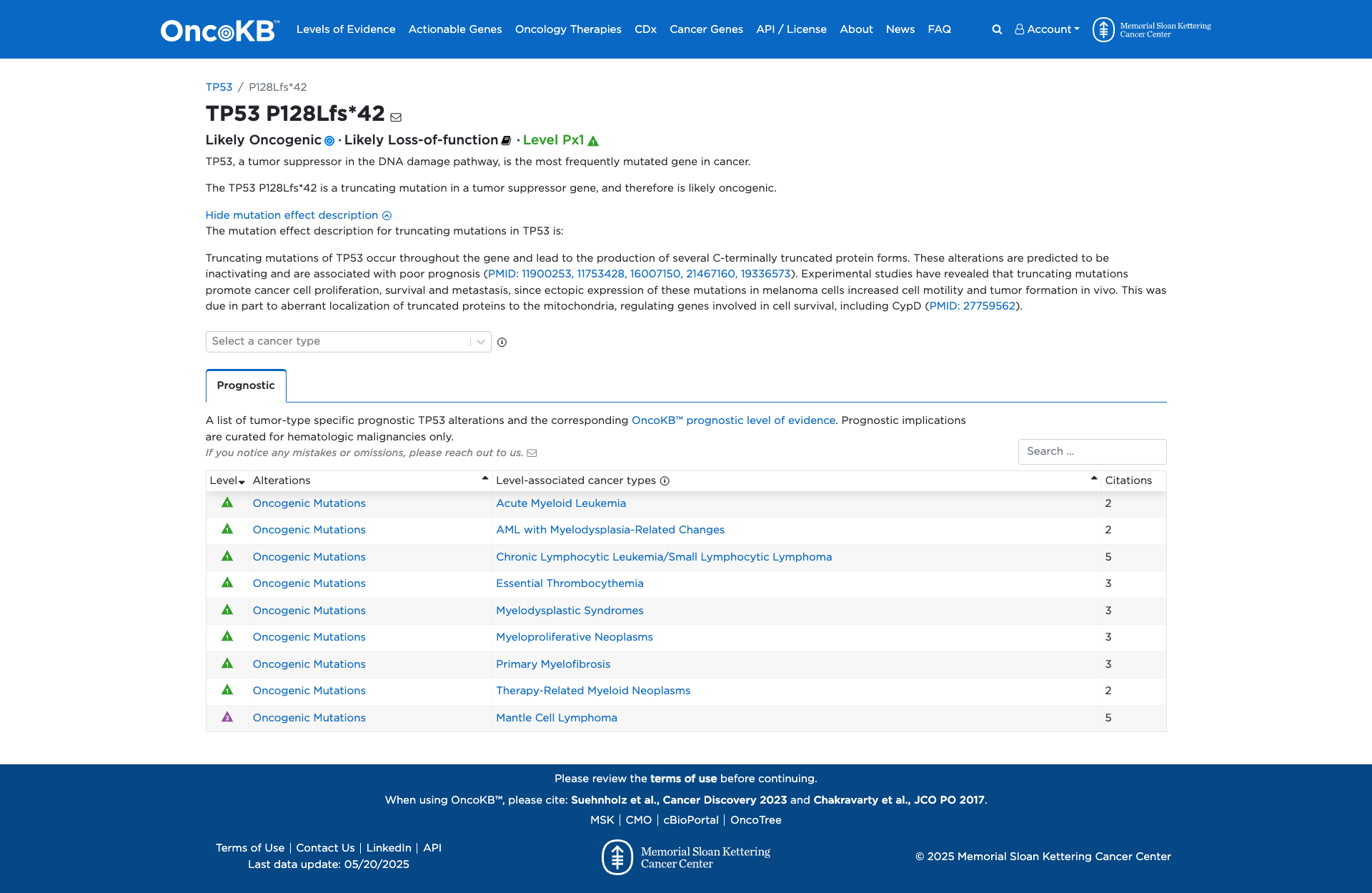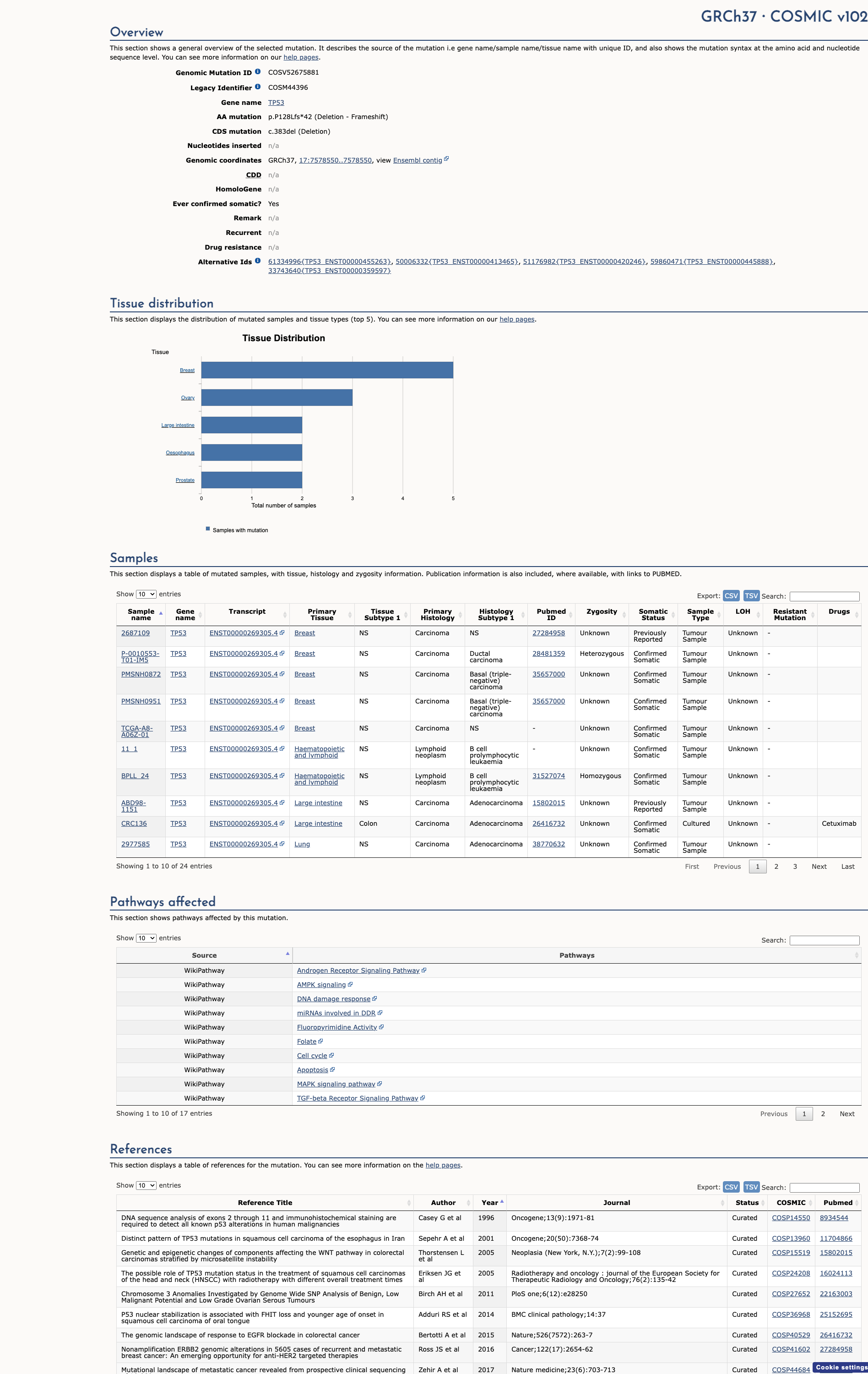TP53 c.383del, p.Pro128LeufsTer42
NM_000546.6:c.383del
COSMIC ID: COSM5198772, COSM5198773
Pathogenic
This TP53 frameshift variant p.P128Lfs*42 is a null variant upstream of p.Lys351 predicted to undergo NMD, meeting PVS1 at Very Strong strength, and is absent from population databases (PM2 Supporting). According to VCEP classification rule Pathogenic-1, PVS1 plus additional criteria supports a final classification of Pathogenic.
ACMG/AMP Criteria Applied
PVS1
PM2
Genetic Information
Gene & Transcript Details
Gene
TP53
Transcript
NM_000546.6
MANE Select
Total Exons
11
Strand
Reverse (−)
Reference Sequence
NC_000017.10
Alternative Transcripts
| ID | Status | Details |
|---|---|---|
| NM_000546.5 | RefSeq Select | 11 exons | Reverse |
| NM_000546.3 | Alternative | 11 exons | Reverse |
| NM_000546.4 | Alternative | 11 exons | Reverse |
| NM_000546.2 | Alternative | 11 exons | Reverse |
Variant Details
HGVS Notation
NM_000546.6:c.383del
Protein Change
P128Lfs*42
Location
Exon 5
(Exon 5 of 11)
5'Exon Structure (11 total)3'
Functional Consequence
Loss of Function
Related Variants
ClinVar reports other pathogenic variants at position 128: P128R
Alternate Identifiers
COSM5198772, COSM5198773
Variant interpretation based on transcript NM_000546.6
Genome Browser
Loading genome browser...
HGVS InputNM_000546:c.383del
Active Tracks
ConservationRefSeqClinVargnomAD
Navigation tips: Use mouse to drag and zoom. Click on features for details.
Clinical Data
Population Frequency
Global Frequency
0.0 in 100,000
Extremely Rare
Global: 0.0%
0%
0.05%
0.1%
1%
5%
10%+
ACMG Criteria Applied
PM2
This variant is not present in gnomAD (PM2 criteria applies).
Classification
2 publications
Pathogenic
Based on 5 submitter reviews in ClinVar
Submitter Breakdown
4 Path
1 VUS
Pathogenic
Likely Path.
VUS
Likely Benign
Benign
Publications (2)
For these reasons, this variant has been classified as Pathogenic. Loss-of-function variants in TP53 are known to be pathogenic (PMID: 20522432). This sequence change creates a premature translational stop signal (p.Pro128Leufs*42) in the TP53 gene. It is expected to result in an absent or disrupted protein product. This variant is not present in population databases (ExAC no frequency). This variant has not been reported in the literature in individuals with TP53-related disease.
Clinical Statement
This variant has been reported in ClinVar as Pathogenic (4 clinical laboratories) and as Uncertain significance (1 clinical laboratories).
COSMIC ID
COSM5198772, COSM5198773
Recurrence
22 occurrences
PM1 Criteria
Applied
Criterion PM1 is applied based on the high recurrence in COSMIC database.
COSMIC Database Preview
Accessing full COSMIC database details requires institutional login or subscription. External links may prompt for authentication.
Functional Impact
Functional Domain
Hotspot Status
Hotspot
PM1
Mutation Count
1326
Reported mutations in this domain
050100+
Domain Summary
This variant is located in a mutational hotspot or critical domain (1326 mutations).
PM1 criterion applied.
Related Variants in This Domain
ClinVar reports other pathogenic variants at position 128: P128R
PM5 criterion applied.
Functional Summary
The TP53 P128Lfs*42 variant is a truncating mutation in the TP53 gene, a tumor suppressor involved in the DNA damage response pathway. Functional evidence indicates that truncating mutations in TP53 lead to the production of C-terminally truncated proteins, which are predicted to be inactivating. Experimental studies have shown that these mutations promote cancer cell proliferation, survival, and metastasis, partly due to aberrant localization of truncated proteins to the mitochondria, affecting genes involved in cell survival. Therefore, the TP53 P128Lfs*42 variant is functionally characterized as likely damaging.
Database Previews
OncoKB

JAX-CKB

Click on previews to view full database entries. External databases may require institutional access.
Computational Analysis
Pathogenicity Predictions
Predictor Consensus
Unknown
PP3 Applied
No
VCEP Guidelines
Applied ACMG/AMP Criteria (VCEP Specific) VCEP Guidelines
PVS1
PVS1 (Very Strong)
According to VCEP guidelines, the rule for PVS1 is: 'Nonsense or frameshift variants: PVS1 applies to variants predicted to result in nonsense-mediated decay (NMD) for frameshift induced premature termination codon (PTC) upstream of p.Lys351.' The evidence shows p.P128Lfs*42 introduces a PTC at amino acid ~170, upstream of p.Lys351, and is predicted to undergo NMD. Therefore, this criterion is applied at Very Strong strength because the variant is a truncating frameshift predicted to undergo NMD in a LOF disease mechanism.
PS1
PS1 (Not Applied) Strength Modified
According to standard ACMG guidelines, PS1 applies when a variant results in the same amino acid change as a previously established pathogenic variant. This is a frameshift variant, not a missense change matching an existing pathogenic amino acid substitution. Therefore, PS1 is not applied.
PS2
PS2 (Not Applied) Strength Modified
According to standard ACMG guidelines, PS2 requires confirmed de novo occurrence in a patient with the disease and no family history. No parental or de novo data are available for this variant. Therefore, PS2 is not applied.
PS3
PS3 (Not Applied) Strength Modified
According to VCEP guidelines, PS3 should not be applied at any strength if PVS1 is applied at full strength. Although functional studies support damaging effect, PVS1 Very Strong precludes PS3. Therefore, PS3 is not applied.
PS4
PS4 (Not Applied) Strength Modified
According to VCEP guidelines, PS4 requires case-control or proband data points to reach specified thresholds. No proband count or case-control data are provided. Therefore, PS4 is not applied.
PM1
PM1 (Not Applied) Strength Modified
According to VCEP guidelines, PM1 (Moderate) applies only to germline missense variants at specific hotspot codons or somatic hotspots. This variant is a frameshift, not a missense hotspot. Therefore, PM1 is not applied.
PM2
PM2 (Supporting) Strength Modified
According to VCEP guidelines, PM2 should be applied at Supporting level when allele frequency is <0.003% in gnomAD. The variant is absent from gnomAD (MAF=0). Therefore, PM2 is applied at Supporting strength because it is not found in population controls.
PM3
PM3 (Not Applied) Strength Modified
According to standard ACMG guidelines, PM3 applies to variants detected in trans with a pathogenic variant in recessive disorders. TP53-related disease is not recessive, and no trans observations are applicable. Therefore, PM3 is not applied.
PM4
PM4 (Not Applied) Strength Modified
According to standard ACMG guidelines, PM4 applies to protein length changes other than truncation (e.g., in-frame indels). This is a truncating frameshift variant assessed under PVS1. Therefore, PM4 is not applied.
PM5
PM5 (Not Applied) Strength Modified
According to VCEP guidelines, PM5 applies only to missense variants at residues with other pathogenic missense changes. This variant is a frameshift, not missense. Therefore, PM5 is not applied.
PM6
PM6 (Not Applied) Strength Modified
According to standard ACMG guidelines, PM6 applies to assumed de novo cases without confirmation. No de novo evidence is available. Therefore, PM6 is not applied.
PP1
PP1 (Not Applied) Strength Modified
According to VCEP guidelines, PP1 requires segregation in multiple affected family members. No segregation data are provided. Therefore, PP1 is not applied.
PP2
PP2 (Not Applied) Strength Modified
According to standard ACMG guidelines, PP2 applies to missense variants in genes with low benign variant rate. This is a frameshift LOF variant. Therefore, PP2 is not applied.
PP3
PP3 (Not Applied) Strength Modified
According to VCEP guidelines, PP3 applies to missense or splice variants with computational evidence. This is a truncating frameshift, and in silico tools are not relevant. Therefore, PP3 is not applied.
PP4
PP4 (Not Applied) Strength Modified
According to standard ACMG guidelines, PP4 applies when patient phenotype is highly specific for a disease with single genetic etiology. No phenotype data are provided. Therefore, PP4 is not applied.
PP5
PP5 (Not Applied) Strength Modified
According to VCEP guidelines, PP5 is not included in the TP53 specification and is generally deprecated. Although ClinVar reports exist, this code is not applied. Therefore, PP5 is not applied.
BA1
BA1 (Not Applied) Strength Modified
According to VCEP guidelines, BA1 requires allele frequency ≥0.1% in gnomAD. The variant is absent. Therefore, BA1 is not applied.
BS1
BS1 (Not Applied) Strength Modified
According to VCEP guidelines, BS1 requires allele frequency ≥0.03% but <0.1% in gnomAD. The variant is absent. Therefore, BS1 is not applied.
BS2
BS2 (Not Applied) Strength Modified
According to VCEP guidelines, BS2 requires observation in healthy elderly individuals. No such data are available. Therefore, BS2 is not applied.
BS3
BS3 (Not Applied) Strength Modified
According to VCEP guidelines, BS3 applies to functional studies showing no LOF. Functional evidence shows LOF. Therefore, BS3 is not applied.
BS4
BS4 (Not Applied) Strength Modified
According to VCEP guidelines, BS4 requires lack of segregation in affected members. No segregation data exist. Therefore, BS4 is not applied.
BP1
BP1 (Not Applied) Strength Modified
According to standard ACMG guidelines, BP1 applies to missense variants in genes where only truncating variants cause disease. This is a truncating variant. Therefore, BP1 is not applied.
BP2
BP2 (Not Applied) Strength Modified
According to standard ACMG guidelines, BP2 applies when variant observed in cis with a pathogenic variant. No such observation is reported. Therefore, BP2 is not applied.
BP3
BP3 (Not Applied) Strength Modified
According to standard ACMG guidelines, BP3 applies to in-frame indels in repetitive regions without known function. This is a frameshift truncating variant. Therefore, BP3 is not applied.
BP4
BP4 (Not Applied) Strength Modified
According to VCEP guidelines, BP4 applies to computational evidence for missense/splice variants. Not relevant for frameshift. Therefore, BP4 is not applied.
BP5
BP5 (Not Applied) Strength Modified
According to standard ACMG guidelines, BP5 applies when variant is found in a case with an alternate molecular basis for disease. No such data are presented. Therefore, BP5 is not applied.
BP6
BP6 (Not Applied) Strength Modified
According to standard ACMG guidelines, BP6 applies to reputable source reports of benign. No such reports exist. Therefore, BP6 is not applied.
BP7
BP7 (Not Applied) Strength Modified
According to VCEP guidelines, BP7 applies to synonymous or deep intronic variants with no splicing impact. This is a truncating variant. Therefore, BP7 is not applied.

